Examples of modern apparent wind indicators for dinghies and open keelboats
 |  |
An apparent wind indicator, as found on sailboat, is a small weather vane or arrow that gives an indication of the current apparent wind direction. This indication allows the skipper to set their sails or their course for best performance, according to the points of sail.
The device is often referred to as a Windex, which is a trademark owned by Davis Instruments. [1]
 |  |

Sailing employs the wind—acting on sails, wingsails or kites—to propel a craft on the surface of the water, on ice (iceboat) or on land over a chosen course, which is often part of a larger plan of navigation.

Wind chill is the sensation of cold produced by the wind for a given ambient air temperature on exposed skin as the air motion accelerates the rate of heat transfer from the body to the surrounding atmosphere. Its values are always lower than the air temperature in the range where the formula is valid. When the apparent temperature is higher than the air temperature, the heat index is used instead.

Apparent wind is the wind experienced by a moving object.
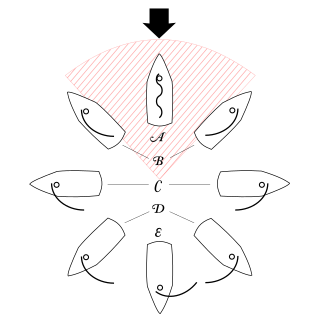
A point of sail is a sailing craft's direction of travel under sail in relation to the true wind direction over the surface.
In common usage, wind gradient, more specifically wind speed gradient or wind velocity gradient, or alternatively shear wind, is the vertical component of the gradient of the mean horizontal wind speed in the lower atmosphere. It is the rate of increase of wind strength with unit increase in height above ground level. In metric units, it is often measured in units of meters per second of speed, per kilometer of height (m/s/km), which reduces inverse milliseconds (ms−1), a unit also used for shear rate.

A spinnaker is a sail designed specifically for sailing off the wind on courses between a reach to downwind. Spinnakers are constructed of lightweight fabric, usually nylon, and are often brightly colored. They may be designed to perform best as either a reaching or a running spinnaker, by the shaping of the panels and seams. They are attached at only three points and said to be flown.

Running rigging is the rigging of a sailing vessel that is used for raising, lowering, shaping and controlling the sails on a sailing vessel—as opposed to the standing rigging, which supports the mast and bowsprit. Running rigging varies between vessels that are rigged fore and aft and those that are square-rigged.

Sail components include the features that define a sail's shape and function, plus its constituent parts from which it is manufactured. A sail may be classified in a variety of ways, including by its orientation to the vessel and its shape,. Sails are typically constructed out of flexible material that is shaped by various means, while in use, to offer an appropriate airfoil, according to the strength and apparent direction of the wind. A variety of features and fittings allow the sail to be attached to lines and spars.
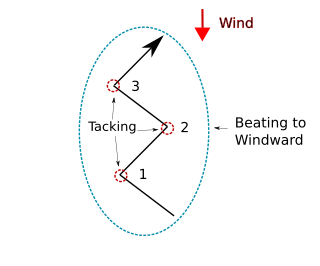
Tacking or coming about is a sailing maneuver by which a sailing craft, whose next destination is into the wind, turns its bow toward and through the wind so that the direction from which the wind blows changes from one side of the boat to the other, allowing progress in the desired direction. Sailing vessels are unable to sail higher than a certain angle towards the wind, so "beating to windward" in a zig-zag fashion with a series of tacking maneuvers, allows a vessel to sail towards a destination that is closer to the wind that the vessel can sail directly.

Velella is a monospecific genus of hydrozoa in the Porpitidae family. Its only known species is Velella velella, a cosmopolitan free-floating hydrozoan that lives on the surface of the open ocean. It is commonly known by the names sea raft, by-the-wind sailor, purple sail, little sail, or simply Velella.
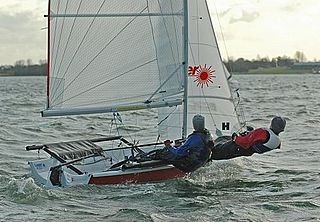
The Laser 4000 is a racing dinghy designed by Phil Morrison crewed by two persons. Its one-design weight-equalised system enables physically differing sailors to compete on a level playing field. It is most popular in Europe, particularly the UK, France and Italy.
The P-Class is a type of small single sail dinghy, popular as a training boat for young people in New Zealand. This class is famous for being the sailing trainer vessel for many new entrants into the sport, and virtually every famous New Zealand yachtsman, including Dean Barker and Russell Coutts, learnt to sail in one. The P-Class was for many years the most common sailing boat in New Zealand.

A wingsail, twin-skin sail or double skin sail is a variable-camber aerodynamic structure that is fitted to a marine vessel in place of conventional sails. Wingsails are analogous to airplane wings, except that they are designed to provide lift on either side to accommodate being on either tack. Whereas wings adjust camber with flaps, wingsails adjust camber with a flexible or jointed structure. Wingsails are typically mounted on an unstayed spar—often made of carbon fiber for lightness and strength. The geometry of wingsails provides more lift, and a better lift-to-drag ratio, than traditional sails. Wingsails are more complex and expensive than conventional sails.

An asymmetrical spinnaker is a sail used when sailing between about 90 and 165 degrees from the angle of the wind. Also known as an "asym", "aspin", or "A-sail" it can be described as a cross between a genoa jib and a spinnaker. It is asymmetric like a genoa, but like a spinnaker, its luff is unstructured; its leading edge is allowed to float freely, unencumbered by an internal wire or hanks attaching it to a stay. Unlike a symmetric spinnaker, the asymmetric does not require a spinnaker pole, since it is fixed (tacked) to the bow or bowsprit. The asymmetrical spinnaker has a larger camber than a genoa and a Spinnaker Mid-Gerth (SMG) -- also called Spinnaker Half Width (SHW) -- measurement greater than the length of its foot.

Wind-powered vehicles derive their power from sails, kites or rotors and ride on wheels—which may be linked to a wind-powered rotor—or runners. Whether powered by sail, kite or rotor, these vehicles share a common trait: As the vehicle increases in speed, the advancing airfoil encounters an increasing apparent wind at an angle of attack that is increasingly smaller. At the same time, such vehicles are subject to relatively low forward resistance, compared with traditional sailing craft. As a result, such vehicles are often capable of speeds exceeding that of the wind.

USA-17 is a sloop rigged racing trimaran built by the American sailing team BMW Oracle Racing to challenge for the 2010 America's Cup. Designed by VPLP Yacht Design with consultation from Franck Cammas and his Groupama multi-hull sailing team, BOR90 is very light for her size being constructed almost entirely out of carbon fiber and epoxy resin, and exhibits very high performance being able to sail at 2.0 to 2.5 times the true wind speed. From the actual performance of the boat during the 2010 America's Cup races, it can be seen that she could achieve a velocity made good upwind of over twice the wind speed and downwind of over 2.5 times the wind speed. She can apparently sail at 20 degrees off the apparent wind. The boat sails so fast downwind that the apparent wind she generates is only 5-6 degrees different from that when she is racing upwind; that is, the boat is always sailing upwind with respect to the apparent wind. An explanation of this phenomenon can be found in the article on sailing faster than the wind.
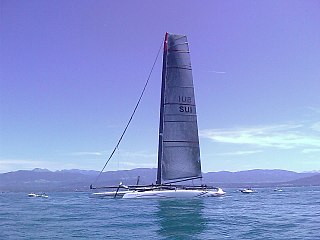
Alinghi 5 is a 90 ft (27 m) (LWL), 90 ft (27 m) beam sloop-rigged catamaran built by Alinghi for the 33rd America's Cup.

High-performance sailing is achieved with low forward surface resistance—encountered by catamarans, sailing hydrofoils, iceboats or land sailing craft—as the sailing craft obtains motive power with its sails or aerofoils at speeds that are often faster than the wind on both upwind and downwind points of sail. Faster-than-the-wind sailing means that the apparent wind angle experienced on the moving craft is always ahead of the sail. This has generated a new concept of sailing, called "apparent wind sailing", which entails a new skill set for its practitioners, including tacking on downwind points of sail.
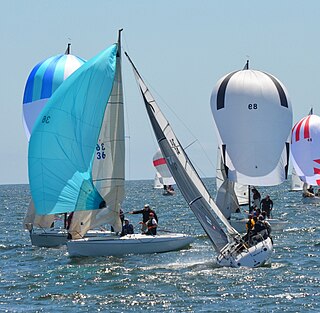
Forces on sails result from movement of air that interacts with sails and gives them motive power for sailing craft, including sailing ships, sailboats, windsurfers, ice boats, and sail-powered land vehicles. Similar principles in a rotating frame of reference apply to windmill sails and wind turbine blades, which are also wind-driven. They are differentiated from forces on wings, and propeller blades, the actions of which are not adjusted to the wind. Kites also power certain sailing craft, but do not employ a mast to support the airfoil and are beyond the scope of this article.

A sail is a tensile structure, which is made from fabric or other membrane materials, that uses wind power to propel sailing craft, including sailing ships, sailboats, windsurfers, ice boats, and even sail-powered land vehicles. Sails may be made from a combination of woven materials—including canvas or polyester cloth, laminated membranes or bonded filaments, usually in a three- or four-sided shape.